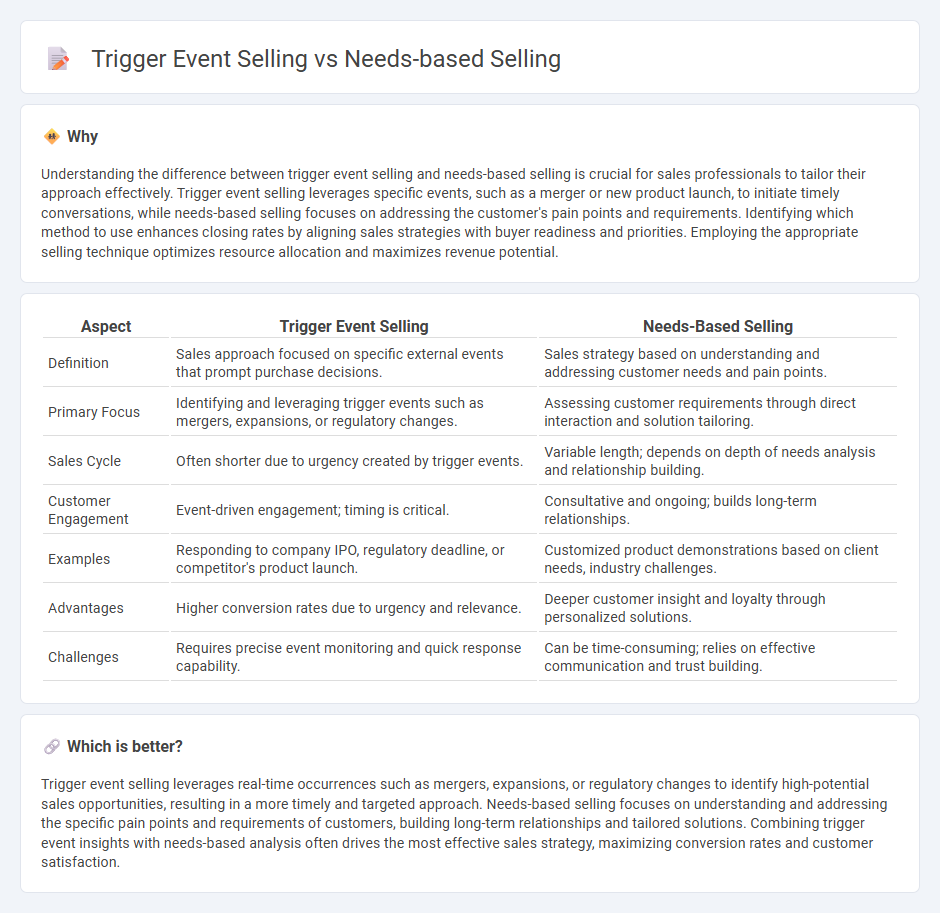
Trigger event selling leverages specific moments of change or urgency, such as mergers, product launches, or regulatory shifts, to initiate timely sales conversations tailored to immediate customer needs. Needs-based selling focuses on understanding and addressing the underlying pain points and long-term requirements of prospects through consultative dialogue and solution alignment. Explore how combining these approaches can maximize sales effectiveness and customer engagement.
Why it is important
Understanding the difference between trigger event selling and needs-based selling is crucial for sales professionals to tailor their approach effectively. Trigger event selling leverages specific events, such as a merger or new product launch, to initiate timely conversations, while needs-based selling focuses on addressing the customer's pain points and requirements. Identifying which method to use enhances closing rates by aligning sales strategies with buyer readiness and priorities. Employing the appropriate selling technique optimizes resource allocation and maximizes revenue potential.
Comparison Table
| Aspect | Trigger Event Selling | Needs-Based Selling |
|---|---|---|
| Definition | Sales approach focused on specific external events that prompt purchase decisions. | Sales strategy based on understanding and addressing customer needs and pain points. |
| Primary Focus | Identifying and leveraging trigger events such as mergers, expansions, or regulatory changes. | Assessing customer requirements through direct interaction and solution tailoring. |
| Sales Cycle | Often shorter due to urgency created by trigger events. | Variable length; depends on depth of needs analysis and relationship building. |
| Customer Engagement | Event-driven engagement; timing is critical. | Consultative and ongoing; builds long-term relationships. |
| Examples | Responding to company IPO, regulatory deadline, or competitor's product launch. | Customized product demonstrations based on client needs, industry challenges. |
| Advantages | Higher conversion rates due to urgency and relevance. | Deeper customer insight and loyalty through personalized solutions. |
| Challenges | Requires precise event monitoring and quick response capability. | Can be time-consuming; relies on effective communication and trust building. |
Which is better?
Trigger event selling leverages real-time occurrences such as mergers, expansions, or regulatory changes to identify high-potential sales opportunities, resulting in a more timely and targeted approach. Needs-based selling focuses on understanding and addressing the specific pain points and requirements of customers, building long-term relationships and tailored solutions. Combining trigger event insights with needs-based analysis often drives the most effective sales strategy, maximizing conversion rates and customer satisfaction.
Connection
Trigger event selling and needs-based selling are interconnected through their focus on identifying and responding to key moments that reveal customer needs. Trigger events such as company expansions, leadership changes, or industry shifts create opportunities for sales professionals to offer tailored solutions aligned with evolving client requirements. By leveraging these events, sales teams can effectively address specific pain points, enhancing the relevance and impact of their needs-based selling strategies.
Key Terms
**Needs-Based Selling:**
Needs-based selling prioritizes understanding the customer's specific pain points and requirements to tailor solutions that directly address those needs. This approach involves active listening, in-depth questioning, and personalized recommendations, fostering stronger customer relationships and higher satisfaction. Discover the key strategies to effectively implement needs-based selling and boost your sales success.
Consultative Questions
Needs-based selling emphasizes identifying and addressing the specific requirements of a customer through consultative questions that uncover pain points and desired outcomes. Trigger event selling leverages timely occurrences, such as mergers or product launches, to ask relevant questions that align solutions with evolving client needs. Explore our guide to master consultative questioning techniques for both selling strategies.
Pain Points
Needs-based selling centers on identifying and addressing a customer's specific pain points through tailored solutions, enhancing the relevance of the sales approach. Trigger event selling leverages external changes or occurrences, such as market shifts or organizational milestones, to initiate conversations that align with the client's evolving needs. Explore how both strategies can optimize targeting and conversion by understanding the critical moments and core challenges customers face.
Source and External Links
Ways Needs-Based Selling Can Boost Your Sales Performance - Needs-based selling is a customer-centric sales approach focusing on understanding and meeting customers' needs through active listening and tailored solutions, leading to stronger relationships and higher sales performance.
Needs-Based Selling Guide - Salesify - Also known as consultative selling, needs-based selling prioritizes identifying and addressing each customer's specific needs and challenges to deliver tailored solutions and boost trust and sales outcomes.
Defining Needs Based Selling | Richardson Sales Performance - Needs-based selling involves understanding the customer's goals and challenges first, then positioning products or services as solutions tailored to those needs, contrasting with traditional feature-driven selling.
 dowidth.com
dowidth.com